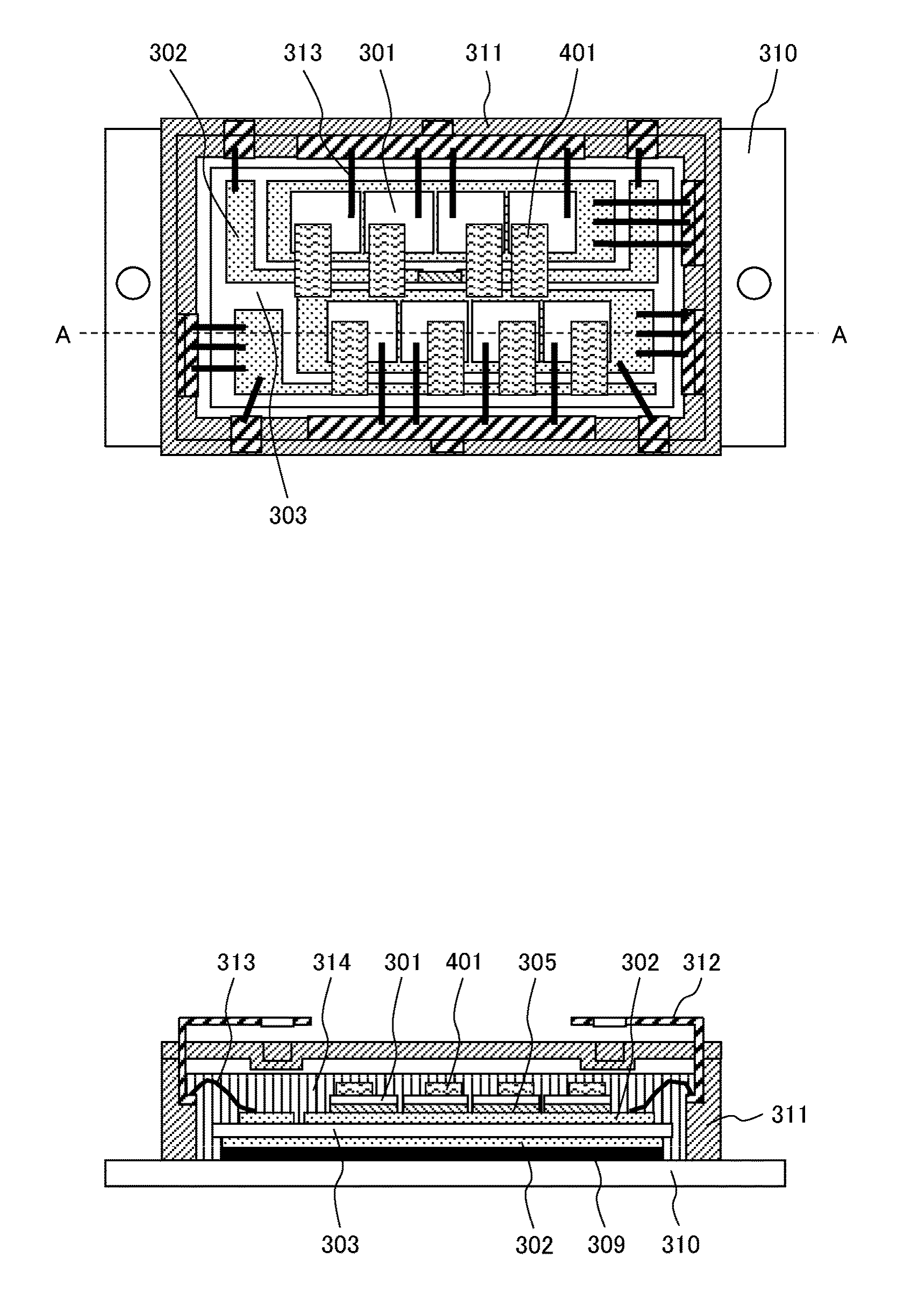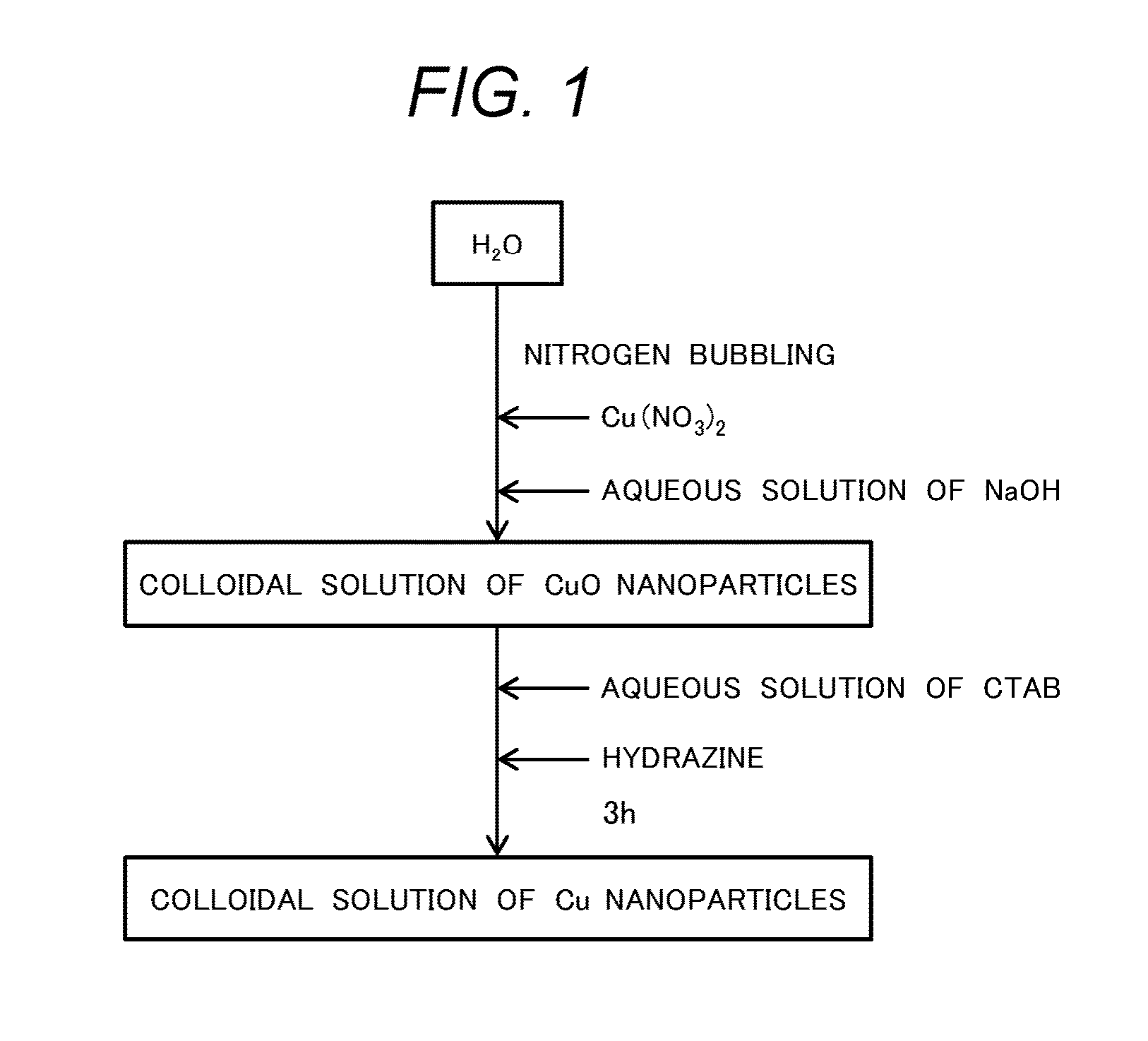Sinterable bonding material using copper nanoparticles, process for producing same, and method of bonding electronic component
a technology of sinterable bonding material and copper nanoparticles, which is applied in the direction of non-conductive materials with dispersed conductive materials, printed circuit assembling, solid-state devices, etc., can solve the problems of difficult sintering in atmospheric air, difficult low-temperature sintering per se, and oxidized copper. oxidation and the effect of bondability
- Summary
- Abstract
- Description
- Claims
- Application Information
AI Technical Summary
Benefits of technology
Problems solved by technology
Method used
Image
Examples
example 1
(Preparation of Copper Nanoparticles)
[0103]As a starting compound for copper, a powder of Cu (NO3)2.3H2O was used, water was used as a solvent. NaOH was used as a precipitating agent of cupric oxide nanoparticles. 1.932 g of a powder of Cu(NO3)2.3H2O was added to 784.8 mL of distilled water subjected to nitrogen bubbling for 30 minutes in a beaker of 1,000 mL volume, and the powder was dissolved uniformly in a water bath at 20° C. and 80° C. Then, by dropping 15.2 mL of a 1.0 M aqueous solution of NaOH, a colloidal liquid dispersion of cupric oxide nanoparticles was prepared.
[0104]Then, after stirring the colloidal liquid dispersion of cupric oxide nanoparticles at a room temperature for 24 hours, 1.82 g of CTAB was dissolved in 190.3 mL of water, to which 9.7 mL of hydrazine was dropped to prepare a colloidal liquid dispersion of copper nanoparticles.
[0105]The obtained copper nanoparticles were subjected to centrifugal separation (centrifugal cleaning machine, Suprema 21 manufactur...
example 2
(Bonding Strength Test on Sinterable Bonding Material)
[0119]A bonding strength test was performed while simulating bonding between electronic components to each other. The test method is as shown below.
[0120]As a copper specimen for measurement, a lower test specimen of 10 mm diameter and 5 mm thickness and an upper test specimen of 5 mm diameter and 2 mm thickness were used. The sinterable bonding material was coated on the upper surface of the lower test specimen and dried at 80° C. under a reduced pressure for one hour. Subsequently, the upper test specimen was placed over the dried sinterable bonding material. A sintering heat treatment was performed in hydrogen at a temperature of 400° C. for 5 minutes while simultaneously applying a load at a surface pressure of 1.2 MPa to obtain a bonded test specimen.
[0121]A shear stress was loaded on the bonded test specimen by using a shear tester (Bond tester SS-100KP, maximum load 100 kg, manufactured by Nissin Shoji Co.) (shear rate: 30...
example 3
(Application to Cooling Unit)
[0126]Description is to be made to an example of using a sinterable bonding material of the present invention for pin connection of a pin fin cooling unit of a semiconductor power module.
[0127]In the semiconductor power module, since the amount of heat generation have tended to be increased in recent years, a technique of efficiently dissipating the heat generated during operation to the outside of the module has become important more and more.
[0128]FIG. 6 is a schematic cross sectional view showing an example of a wiring substrate and a pin fin cooling unit used in a semiconductor power module.
[0129]As shown in the drawing, a wiring substrate 14 has a structure of stacking a circuit wiring 11 to be connected with a semiconductor chip, an insulation substrate 12 for electrically insulating a semiconductor chip and the circuit wiring 11 in the inside of a module, and a metallized layer 13 for soldering the insulation substrate 12 and the pin fin cooling u...
PUM
| Property | Measurement | Unit |
|---|---|---|
| particle diameter | aaaaa | aaaaa |
| particle diameter | aaaaa | aaaaa |
| particle diameter | aaaaa | aaaaa |
Abstract
Description
Claims
Application Information
 Login to View More
Login to View More - R&D
- Intellectual Property
- Life Sciences
- Materials
- Tech Scout
- Unparalleled Data Quality
- Higher Quality Content
- 60% Fewer Hallucinations
Browse by: Latest US Patents, China's latest patents, Technical Efficacy Thesaurus, Application Domain, Technology Topic, Popular Technical Reports.
© 2025 PatSnap. All rights reserved.Legal|Privacy policy|Modern Slavery Act Transparency Statement|Sitemap|About US| Contact US: help@patsnap.com



